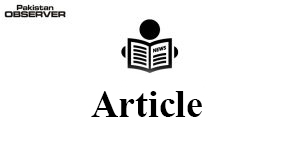Dr M Athar Khan
LET me remind the readers that in this series of articles all that has proceeded and all of what follows next has specific reference to what the then Education Minister of Pakistan Mr. Fazlur Rahman, had said 68 year ago in his address to the Educational Conference held at Karachi in December 1951 to discuss the six-year national plan of educational development for Pakistan and other educational problems and which is equally true for the present times also. He had observed that reason for the situation of education in the country was nothing other than that the education planners and decision makers of the country were the product of a system of education which was based purely on Western values and had ignored our religion and culture. Consequently their knowledge of Islam, its history, its culture, and the role it had played in the advancement of mankind was either superficial or inadequate and they felt diffident when it came to giving a practical shape to the policy of the Government whereby the entire educational system was to be reorganized and based on Islamic ideology. The present series of articles on Madrassah-the Islamic Institution of Education is intended to acquaint with, and inculcate in, the ‘present’ and ‘would be’ teachers, education planners, decision makers and administrators the knowledge of the Islamic system and institution of education which has so far been missing in the curriculum of the colleges and institutes of education and research of the country’s universities.
Iq’ra context and basics of the Islamic education highlight Ni’yat, Sanctity and Value of Ilm in Islam. Categories and integration of language, Islamic, social studies, mathematical sciences and natural sciences are the elemental fields of knowledge that together constitute and define the concept and scope of Al-Manahij Al-Darasiyah in the institutional context of Madrassah. A near equivalent of the Arabic term Al-Manahij Al-Darasiyah is the English world Curriculum. However, as it is true for all language words, they have definite cultural and institutional contexts, which determine and form concepts and meanings of words in languages, the term Al-Manahij Al-Darasiyah has definite cultural and institutional context which is not equally translatable in any other language of the world. In its uniqueness and context the term Al-Manahij Al-Darasiyah as specific to the Islamic Institution of Madrassah includes all and more of the elements of curriculum as they are conceived and defined in the modern world of education. And yet the words that define the modern concept of curriculum, in Al-Manahij Al-Darasiyah have their own concepts and meanings. As a matter of principle, the concept of Al-Manahij Al-Darasiyah and all its elements are derivatives of the Qur’anic and Islamic concepts of Ilm and related concepts as they are implied in the meanings of the words and verses of the Qur’an. Following are the elements that are specific to Al-Manahij Al-Darasiyah.
1. Aim of Al-Manahij Al-Darasiyah is to inculcate in students Ilm (knowledge combined with practicality and practice and vice versa) of what is taught and learnt in the Madrassah. 2. Content in Al-Manahij Al-Darasiyah denotes only good and useful knowledge and practical work combined that is prescribed for teaching and learning specific subjects or skills. Knowledge work in Al-Manahij Al-Darasiyah refers to the integrated whole of basic fields of knowledge as presented earlier (article-5) in the order of hierarchy and in relationship of interdependence. In content the good and useful knowledge mean that they must be within the limits and fulfil the criteria set in terms of Iq’ra, Ilm, Ibaadah and Kasab as described earlier in the article-3. 3. Principles and methods of instruction for teaching content are based on the Qur’anic principles and methods of teaching which include the following: Qur’anic principles of teaching: The Qur’anic principles of teaching include (1) Niyat Intent both for teaching and learning the knowledge and skills that are good and useful): (2) Dividing subject text into lesson units that are absorbable by students and teachable within judiciously and reasonably stipulated period of time: (3) Relating subject lessons to circumstances, conditions, needs and experiences of the students: (4) Specifying the lesson content in terms of what, why as it is significant in the place and meaning of the Surah Fatiha in the Qur’an:
(5) Readiness for teaching and learning of the content refers to preparedness (required knowledge and level of scholarship or expertise) and willingness (Niyat) of the teacher to teach and of the student to learn: (6) Statement of purpose of the lesson in terms of the benefit and end result of the lesson: (7) Instructions about student conduct during lesson: (8) Effective communication and student-teacher contact which is an important aspect of the culture of the Madrassah: (9) Simplification of subject lesson (as explained below under the Qur’anic methods of teaching) and (10) Specification and management of time which is an unique feature of Al-Manahij Al-Darasiyah. It begins with Salat-e-Fajr and continues to after Salat-e-Isha, between which each time period has special significance for learning. Qur’anic methods of teaching include Lecture (khitab), Imitation (taqleed), Experiment (tajribah), Demonstration (izhar), Observation (mushahadah), Analogy (mathal), Dialogue (mukaalamah), Repetition (takraar), Visits (as-sair), Reasoning (daleel), Comparison (mawaznah), Question-Answer, Didactics and Narratives (qissa or hikayat). 4. Evaluation in Madrassah is based on the objective of Al-Manahij Al-Darasiyah, which focuses assessment of students’ achievements both in areas of knowledge and its practicality as it is demonstrable in the learners’ behavioural ability and competence to apply knowledge to practise and vice versa.
—The writer is Prof & Advisor to the VC, Sarhad University, Peshawar.










